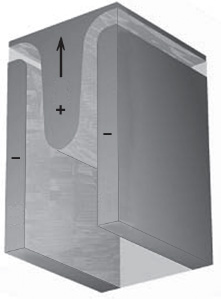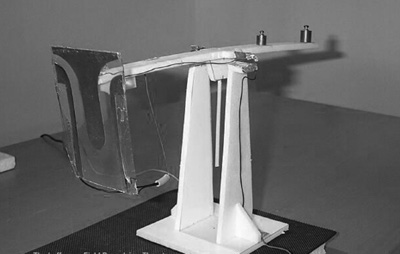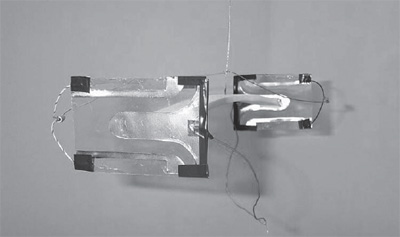Secrets of Antigravity Propulsion (50 page)

12.6 • THE LAFFORGUE THRUSTER
French inventor Jean-Claude Lafforgue has patented an asymmetrical capacitor field propulsion thruster having a shape similar to that shown in figure 12.14.
22
Like Brown’s asymmetrical capacitor, Lafforgue’s device develops a net thrust through unbalanced electrostatic forces, with the thrust acting in the same direction regardless of plate polarity.
To determine the thrust acting on his capacitor, Lafforgue calculated the magnitude and direction of the force per unit surface area acting on the capacitor’s plates at various plate locations, this quantity alternately being referred to as the
force density
or the
electrostatic pressure
,
P
.
It is mathematically expressed as:
P
=
F
/A =
E
•q/A =
E
•σ, in which
F
is electrostatic force, A is surface area,
E
is electric force-field intensity, q is charge, and σ is surface-charge density.
Thus, he relies on the conventional practice of calculating electrostatic force as the product of the electric field intensity and the electric charge.

Figure 12.14.
The Jean-Claude Lafforgue field propulsion thruster.
(Adapted from Lafforgue’s 1991 patent)
Subquantum kinetics achieves the same outcome, except that it works with the negative electric-potential gradient, –
∇
φ, instead of electric force-field intensity, with the two being equivalent
(i.e.,
E
= –
∇
φ).
As mentioned earlier, subquantum kinetics prefers to work with energy potential (ether concentration), since it regards this as the real existent rather than the force-field intensity.
Lafforgue’s approach of summing the electrostatic pressures acting over a particular plate surface area to get a resultant force vector is equivalent to the subquantum kinetics approach of multiplying the field-potential gradient present on a given electrode sector by the surface-charge density present in that sector and summing the resulting force vectors.
This approach was described earlier in analyzing the electrostatic forces acting on Brown’s electrokinetic apparatus (see
chapter 3, section 3.3
).
Also, Lafforgue proposed that the electric field intensity is seated in the local space-time continuum and, hence, exerts its force on the plate surface charges from a reference frame that is not attached to the capacitor.
Thus, any resulting force imbalance would be able to displace the capacitor as a whole.
Lafforgue’s approach, which presumably was arrived at through experience gained from experimental observation, is in accord with the theoretical approach of subquantum kinetics, which views the electric-field potential as being seated in the ether and able to act on a capacitor independent of the capacitor’s reference frame and thereby cause it to be displaced.
Subquantum kinetics, though, goes into much greater detail to explain how the electrostatic potential field is generated and how it exerts its force on a charge without any countering reaction force.
Since the approaches of Lafforgue and of sub-quantum kinetics were developed independently and produced similar conclusions, we are reassured from both observation and theory that it is correct to conclude that unbalanced electrostatic forces can propel an asymmetrical capacitor if it is properly designed.
An analysis of how unbalanced forces form on the Lafforgue capacitor is presented in the text box below.
Analysis of Electrostatic Forces on the Lafforgue Capacitor
The unbalanced thrust acting on the Lafforgue asymmetrical capacitor may be understood to arise as follows.
Referring to figure 12.14, the field lines coming from the upper ends of vertical, negatively charged outer plates diverge as they approach the central, positively charged plate, which curves to a horizontal T-shape at the upper end of the capacitor.
As a result, the field lines and surface charge are more concentrated on the negative electrode than on the positive, which causes the attractive force, or electrostatic pressure, that is directed from the negative electrode out to the positive to be greater than the attractive force that is directed from the positive electrode in toward the negative.
The opposing horizontal components directed in toward the positive electrode cancel one another, but the upward-directed component is unopposed, leaving a net-upward thrust.
In addition, the field lines emerging downward from the lower tip of the central, positively charged electrode diverge toward the horizontal as they approach the two flanking negatively charged electrodes, resulting in a net force, or pressure, directed downward away from the positive electrode.
The forces, or pressures, attracting the two negative electrodes toward the central positive electrode, being for the most part horizontal and opposed to one another, will cancel each other out, leaving the downward residual force on the positive electrode unopposed.
However, since the field gradient at the upper end of the negative electrode is much greater in magnitude than that formed around the lower portion of this central electrode, the upward thrust from the negative electrode will be anywhere from 3 to 18 percent greater than the downward thrust generated at the lower end of the positive electrode.
As a result, a net-upward thrust will act on the capacitor as a whole.
The result will come out the same even, if the positive and negative plate polarities are reversed.
Naudin offers a considerable amount of information about the Lafforgue thruster on his website.
He has taken the force equations given in Lafforgue’s patent, made a few minor corrections, and used them to create a calculator for computing a capacitor’s thrust.
23
Visitors can enter values for a capacitor’s dimensions, charge voltage, and dielectric constant and then compute what thrust would be expected.
For example, a 50-kilogram thruster measuring 38.5 centimeters high, 8.3 centimeters wide, and 33 centimeters long, using a 4,000-K dielectric and charged to 100 kilovolts, is computed to develop a phenomenally high thrust of 0.68 ton, a force that measures almost fourteen times the capacitor’s normal weight!
Thirty of these thrusters would be capable lifting a 20-ton vehicle.
Forward movement could be obtained simply by vectoring the direction of one of the thrusters.
However, experimental data on a high-K Lafforgue thruster that might substantiate these projections is currently not available.
Since barium titanate has a volume resistance of about 10
11
ohmmeters, a capacitor of this size would have a total resistance of about 10
10
ohms, provided that its electrodes are properly insulated from contact with the outside air.
This would amount to a current leakage of 10 microamps, or a power dissipation of 1 watt.
So, theoretically, all thirty thrusters could be powered with a 100-watt power supply.
A propulsion device yielding 20 metric tons of force for a power dissipation of 100 watts would have a thrust-to-power ratio of 2 million newtons per kilowatt, about 130,000 times that of a jet engine.
However, it is likely that due to the opposing thrust vector developed by its polarized dielectric, the Lafforgue thruster loses its thrust once it becomes fully charged.
Hence, like Brown’s electrokinetic apparatus, it may need to be repeatedly charged and discharged to create a continuing thrust effect.
If 30 of these Lafforgue thrusters, then, were to have a combined capacitance of about 30 microfarads and were to be charged to 100 kilovolts once every second, they would draw 300 kilowatts of power.
This would project a lower thrust-to-power ratio of about 670 newtons per kilowatt or about 45 times that of a jet engine.
In his patent, Lafforgue notes that in addition to its use for air transport, his thruster could be used for power generation by mounting a number of thrusters around the circumference of an axis and connecting the axis to a generator.
For example, four thrusters of the size estimated above, each producing 680 kilograms of force and each mounted at the end of a rotor arm extending 2 feet out from the axis, would collectively generate 12,000 foot-pounds of torque.
Spinning at 5,254 rpm, this electrostatic motor would be generating 12,000 horsepower, or 8.95 megawatts, of power.
Accounting for efficiency losses in the electric generator and due to bearing resistance, a motor-generator combination should be capable of producing 5 megawatts of power, but the thrusters would require only 40 kilowatts of power if the capacitors were being charged and discharged once per second.
Hence their output power would exceed their input power by a factor of 125.
Lafforgue’s patent was issued in 1991.
If we are even somewhat close in our thrust projections, the question that arises is, What has everyone been waiting for?
Why aren’t these being offered for sale to power our homes or electric cars?
Is it perhaps that people just don’t believe that something this simple might solve the energy problem?
Indeed, some people’s belief in and subservience to the law of energy conservation (and to Newton’s third law of motion) are so ingrained that they would rather continue to burn oil and gas and ultimately create ecological disaster on our planet than give up their cherished misconceived belief.
Naudin has built and tested some small-size Lafforgue thrusters measuring just 0.5 millimeter thick and has demonstrated that they produce a net thrust just as Lafforgue claims.
Naudin used a low-K epoxy dielectric (K = 3.7) and operated his thruster at a much lower voltage of 9,500 volts, using the test setup shown in figure 12.15.
24
When energized, his Lafforgue thruster generated about 0.03 gram of force, as indicated by the upward swing of the armature.
Naudin commented that he was able to reduce his leakage current to “near zero” by properly insulating his capacitor so that the electrodes were not in contact with the ambient air environment.
By this, he meant that the current was “not measurable in a microampere range.”
Supposing his thruster was drawing less than 1 microamp at 10 kilovolts, this would be a power consumption of less than 10 milliwatts, which amounts to a thrust-to-power ratio of about 30 newtons per kilowatt.

Figure 12.15.
A test of the Lafforgue thruster carried out by
Jean-Louis Naudin.
(Photo courtesy of J.-L.
Naudin, from his website,
http://jnaudin.free.fr/
)

